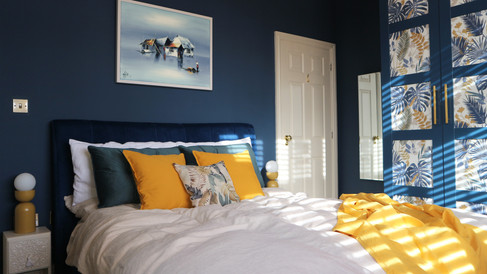Understanding how to master the use of colours!
Colour plays a pivotal role in interior design, acting as a powerful tool to create mood, set the ambiance and evoke emotions within a space. It has the ability to transform a room, making it feel vibrant, serene, cosy or energetic. Colours can be used strategically to highlight architectural features, manipulate the perception of space, and draw attention to focal points. They can express personal style, reflect cultural influences, and convey specific themes.

Below are tips that will help you to understand more about colours and how to carefully select and harmonise colours to bring balance, harmony and visual interest to any room.
1. Understanding the Colour Wheel

The colour wheel is a fundamental tool in interior design, serving as a guide for creating harmonious and visually appealing colour schemes. It consists of primary colours (red/ blue/ yellow), secondary colours (orange/ green/ purple) and tertiary colours (created by mixing primary and secondary colours). The colour wheel also shows how best to combine colours. For example, complementary colours are located opposite each other and create a striking contrast, while analogous colours are adjacent to each other and offer a more harmonious blend.
By understanding the relationships between colours on the wheel, you can select and combine hues effectively to evoke specific moods, highlight focal points, and bring a sense of balance and cohesion to your space.
You can buy a colour wheel here.
2. Setting the mood with colours
Colours have the incredible ability to shape our moods and vibes. They can make a room feel cosy or spacious, calming or energizing. So, when you are picking colours for your home, think about the emotions and experiences you want to create. Warm colours like red, orange, and yellow can create a lively and energetic atmosphere, while cool colours like blue, green, and purple can promote calmness and relaxation, perfect for bedrooms and living areas where you want to unwind. Consider the desired mood of each space and select colours accordingly.
3. The role of lighting
Lighting plays a crucial role in how colours appear as it can dramatically affect their hue, intensity and overall perception. Different lighting sources, such as natural light, incandescent bulbs or fluorescent lighting, have varying colour temperatures that can either enhance or distort the colours in a space. Warm lighting tends to bring out the richness and warmth of colours, while cool lighting can make colours appear cooler or bluer. Additionally, the direction and intensity of lighting can create shadows and highlights, further influencing the way colours are perceived.

It is also important to consider the direction your house faces when it comes to natural lighting.
North-facing rooms receive cooler, indirect light, which can make colours appear slightly colder and darker. To counterbalance this, you can choose warmer colours like soft yellows, creamy neutrals or pastel shades to add warmth and brightness to the space.
East-facing rooms receive abundant morning sunlight, which brings out warmer tones. Consider using cooler colours like blues and greens to balance the early morning warmth and create a soothing and refreshing atmosphere. South-facing rooms receive direct sunlight throughout the day, offering a lot of natural light. These spaces can handle a wide range of colours. You can embrace brighter, bolder shades or go for cooler colours to maintain a pleasant balance and prevent the room from feeling overly warm. West-facing rooms receive warmer, golden light in the afternoon and evening. This light can intensify warm colours, so it is best to choose cooler shades like blues, greys, and greens to counteract the warmth and create a more balanced and relaxing environment.
4. Balance & Contrast
Striking a balance between bold and subtle colours is very important. Too many vibrant hues can overwhelm a space, while an all-neutral scheme may lack visual interest. You should instead use contrasting colours to create focal points or highlight architectural details. You can use the colour wheel to guide you through the selection of effective colour combinations. Colours can also be incorporated through patterns and textures, enhancing visual interest. Experiment with textiles, wallpapers, and rugs that feature a mix of colours and patterns. Use them strategically to add depth and create focal points within a room.
5. Illusion of space
Colour can be a powerful tool to create the illusion of space within interior design.
Lighter colours, such as whites, pastels, and soft neutrals tend to reflect more light and can make a room feel more spacious. Painting walls, ceilings, and even furniture in light hues can visually expand the boundaries of a room.
Using a monochromatic colour scheme, where different shades and tones of the same colour are used, creates a seamless flow and can make a space feel more open and airy.
Another technique is to paint walls and ceilings in the same light colour, eliminating visual boundaries and giving the impression of a larger, more continuous space.
You can also incorporate pops of vibrant or bold accent colours sparingly to create focal points. These accents draw attention and distract from the size of the room, making it feel more interesting and less confined.
Stay tuned and don’t miss the Part II post where I will talk about specific colour blocking techniques and zoning that can instantly elevate your space.
Thank you for reading this post! Subscribe below or follow us on Instagram to read more!
ABOUT MIKA DESIGN STUDIO
Mika Design Studio is an interior design studio on a mission to make a positive and meaningful impact on our clients’ lives; inspire them on the use of creativity and sustainable materials to create authentic interiors that organically evolve with them.
We are based in Royal Leamington Spa (Warwickshire, UK) but also operate online nationwide. We provide Consultation and Home Staging services for properties to sell, Re-design & Styling services for serviced accommodation/buy-to-let properties, and Online Interior Design for single bespoke rooms.
Visit our website to find out more about us.


















Comments